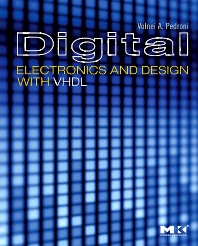Books in Hardware and architecture
Books in Hardware and architecture
- 3rd Edition
- December 5, 2008
- Clive Maxfield
- English
- Paperback9 7 8 1 8 5 6 1 7 5 0 7 4
- eBook9 7 8 0 0 8 0 9 4 9 5 0 5

Bebop to the Boolean Boogie
- 1st Edition
- September 25, 2008
- Vasilis F. Pavlidis + 1 more
- English
- Paperback9 7 8 0 1 2 3 7 4 3 4 3 5
- eBook9 7 8 0 0 8 0 9 2 1 8 6 0

Three-dimensional Integrated Circuit Design
- 1st Edition
- January 25, 2008
- Volnei A. Pedroni
- English
- Hardback9 7 8 0 1 2 3 7 4 2 7 0 4
- eBook9 7 8 0 0 8 0 5 5 7 5 5 7

Digital Electronics and Design with VHDL
- 1st Edition
- September 17, 2007
- Bruce Jacob + 2 more
- English
- Hardback9 7 8 0 1 2 3 7 9 7 5 1 3
- eBook9 7 8 0 0 8 0 5 5 3 8 4 9

Memory Systems
- 1st Edition
- September 14, 2007
- Jack Ganssle + 8 more
- English
- eBook9 7 8 0 0 8 0 5 6 0 7 4 8

Embedded Hardware: Know It All
- 1st Edition
- August 14, 2007
- Jeorge S. Hurtarte + 2 more
- English
- eBook9 7 8 0 0 8 0 5 5 1 1 9 7

Understanding Fabless IC Technology
- 3rd Edition
- June 6, 2007
- David A. Patterson + 1 more
- English
- eBook9 7 8 0 0 8 0 5 5 0 3 3 6

Computer Organization and Design, Revised Printing
- 1st Edition
- December 20, 2006
- Isaak D. Mayergoyz + 1 more
- English
- Hardback9 7 8 0 0 8 0 4 4 4 6 5 9
- eBook9 7 8 0 0 8 0 4 6 7 5 2 8

Spin-stand Microscopy of Hard Disk Data
- 2nd Edition
- July 20, 2006
- Dogan Ibrahim
- English
- Paperback9 7 8 0 7 5 0 6 6 8 7 9 8
- eBook9 7 8 0 0 8 0 4 6 4 9 7 8

PIC Basic Projects
- 3rd Edition
- December 1, 2005
- Khalid Sayood
- English
- eBook9 7 8 0 0 8 0 5 0 9 2 5 9
